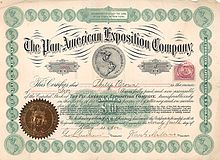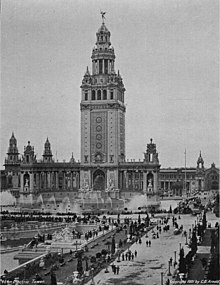Pan-American exposure
| Pan-American Exposition 1901 | |
|---|---|
 Logo of the Pan-American Exposition by Raphael Beck |
|
| motto | "Commercial well being and good understanding among the American Republics" |
| General | |
| Exhibition space | 140 ha |
| new hits | X-ray machine |
| Number of visitors | 8 million |
| BIE recognition | No |
| Place of issue | |
| place | Buffalo |
| terrain | Delaware Park Coordinates: 42 ° 55 ′ 10 " N , 78 ° 52 ′ 47" W |
| calendar | |
| opening | May 1, 1901 |
| closure | November 2, 1901 |
| Chronological order | |
| predecessor | Paris 1900 |
| successor | St. Louis 1904 |
The Pan-American Exposition was a World's Fair , which lasted from May 1 to November 2, 1901 in Buffalo in the US state of New York was held. It was organized by the Pan-American Exposition Company , founded in 1897 .
Venue
Cayuga Island was initially chosen as the venue because this island was close to Niagara Falls , which was a popular tourist destination even then. However, when the Spanish-American War broke out in 1898 , plans to hold the World's Fair were initially frozen.
After the end of the war, Buffalo and Niagara Falls fought a heated duel for the venue, which Buffalo finally won for two reasons: First, the city had a larger population - with around 350,000 inhabitants, the city on Lake Erie was the eighth largest city at the time in the United States - and second, Buffalo had better rail links , allowing more than forty million North Americans to get to the city in a simple day trip. In July 1898, gave the United States Congress 500,000 US dollars for the holding of the exhibition in Buffalo free.
Another factor that has been helpful for Buffalo as the location, was the introduction of three-phase alternating current by Westinghouse , which allowed the transmission of electricity over long distances. The organizers of the exhibition in Buffalo were thus able to use electricity generated in Niagara Falls , forty kilometers away .
Course of the exhibition
The exhibition achieved notoriety because the anarchist Leon Czolgosz committed an assassination attempt on the then US President William McKinley during his visit to the World's Fair on September 6, 1901 in the Temple of Music . McKinley, who was hit by two bullets, had given a speech at the exhibition the day before, in which he stated:
“Exhibitions are the time keepers of progress. They record the world's achievements. They stimulate the energy, enterprise, and intellect of mankind and speed up the human mind. You enter the house. They expand and brighten people's daily life. They open mighty treasure chambers to inform the students ... "
The newly developed X-ray device was shown at the exhibition, but the attending physicians were reluctant to use it at McKinley's treatment to search for the bullet because they did not know what side effects the device would have for the President. It may seem ironic that there was no incandescent lamp on the exhibition grounds in the emergency hospital , even though the facades of many of the world's exhibition buildings were covered with thousands of lightbulbs. Doctors used a pan to reflect sunlight onto the operating table when treating McKinley's wounds. McKinley died eight days later from complications from his injuries.
When the exhibition ended, the buildings that had been built were demolished, the site cleared and divided into residential areas. A block of stone marking the site of the McKinley assassination was placed in a grassy area on Fordham Drive in Buffalo. The only structure that was not demolished was the New York State Building , which was designed to survive the exhibition and still serves as the headquarters of the Buffalo and Erie County Historical Society.
Individual evidence
- ↑ Expositions are the timekeepers of progress. They record the world's advancements. They stimulate the energy, enterprise, and intellect of the people, and quicken human genius. They go into the home. They broaden and brighten the daily life of the people. They open mighty storehouses of information to the student….
Web links
- Doing the Pan (English)
- Illuminations - Revisiting the Buffalo Pan-American Exposition of 1901 ( Memento of August 9, 2011 in the Internet Archive )
- Film recordings and other materials (Library of Congress, English)
- The Buffalo and Erie County Historical Society



